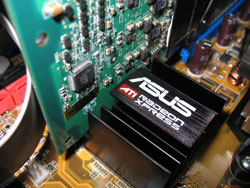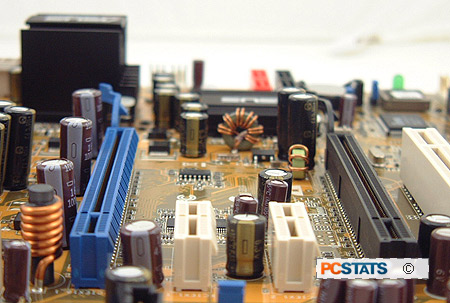A year ago we would have never expected to say this, but
ATi's CrossFire Xpress 3200 (aka the ATi RD580) Northbridge and SB600
Southbridge combo are as strong as the equivalent chipsets from nVidia.
Feature and performance wise, the CrossFire Xpress 3200 should be
considered if you're planning on upgrading or building a new socket AM2
computer. The great news for consumers is that with ATi and nVIDIA both offering good solid socket AM2 chipsets, consumers should see some nice advancements and innovation at the mainboard level. In this way, advanced chipset features like RAID, eSATA port multipliers and new networking technologies have been transitioning from perk to the basic feature set. It's nice to see chipsets evolve after such a long period of non-change.
Where socket AM2 AMD Athlon64 systems are concerned, a
consumers choice for a dual videocard based computer used to pretty limited. With the Xpress 3200, ATI brings its dual videocard Crossfire system to the AMD table, and Intel as well. ATI's CrossFire videocards run on Intel 975X and P965 Express chipsets too. Crossfire is certainly becoming a multi-platform technology.
Probably the best thing ATi has going for the CrossFire Xpress
3200 is its excellent price point. Most 'RD580' motherboards can be had in the
range of $150US - which is less expensive than what nVIDIA's nForce 590 SLI retails
for. The Asus M2R32-MVP is one of the new generation CrossFire Xpress 3200 motherboards, and its feature set certainly looks very tasty.
With a retail price of $167 CDN ($148 US, £79 GBP) the
Asus M2R32-MVP motherboard is moderately priced for a socket AM2 platform.
The M2R32-MVP supports all Socket AM2 processors from the AMD Sempron to Athlon64, X2 and FX processors. There are four DDR2 DIMM slots which accommodate as much as 8GB Of DDR2-800 memory. The two PCI Express x16 slots are obviously for videocards, and Crossfire Edition videocards in particular if dual-card gaming is your thing. The board also has two PCI Express x1 and two 32 bit PCI slots for expansion purposes. Integrated goodies include a SoundMAX 7.1 channel High Definition Azalia audio codec (with a SPDIF audio output for digital audio connections), external SATA, a Gigabit network card and IEEE 1394a among others.
 |
|
|
The Asus M2R32-MVP is a full sized ATX
motherboard, and on it we find a total of 10 USB slots (four available through the
rear I/O), two IEEE 1394a slots and even an eSATA slot for expansion devices. The onboard
Marvel 88E8001 Gigabit (10/1000) network card runs through the PCI bus,
which isn't ideal, but that shouldn't be too big an issue as there aren't many devices
on the PCI bus in this instance.
Asus certainly uses an interesting
component layout on the M2R32-MVP motherboard. Some devices are well space,
and others are overly crowded. For example there is plenty of space around
the CPU socket so you can install larger after market socket AM2 AMD Athlon64 heatsinks,
or water blocks. The Asus M2R32-MVP motherboard's two PCI Express x16 slots are
layed out so there is two full spaces between each slot; a nice design
element since ATI's high end Radeon videocards mostly use dual slot cooling systems.
Cutting it Close... Too Close
So far so good, yet here is where things get a
little odd. The first PCI Express x16 videocard slot on the M2R32-MVP
motherboard is situated a little too close to the passive RD580 Northbridge heatsink. In fact
it's so close that the small aluminum chipset heatsink may actually interfere
with some videocards! Our main concern really resides with videocards that have an
elaborate rear-mounted heatsink, for obvious reasons as the photo to the right
suggests.
 In our
tests with the ASUS M2R32-MVP motherboard PCSTATS used a MSI NX7800GTX-VT2D256E videocard (which adheres to the
reference design), yet there was no more than ~3 mm space between the back
of the card and the metal fins of the heatsink. With such a
slim margin for error, it is very possible that electrical components on the rear of
the videocard, like those pin sized resistors or capacitors, could be damaged by
the heatsink if the two come in contact. Bottom line, just be a
little cautious when installing the upper PCI Express videocard into the M2R32-MVP
motherboard.
In our
tests with the ASUS M2R32-MVP motherboard PCSTATS used a MSI NX7800GTX-VT2D256E videocard (which adheres to the
reference design), yet there was no more than ~3 mm space between the back
of the card and the metal fins of the heatsink. With such a
slim margin for error, it is very possible that electrical components on the rear of
the videocard, like those pin sized resistors or capacitors, could be damaged by
the heatsink if the two come in contact. Bottom line, just be a
little cautious when installing the upper PCI Express videocard into the M2R32-MVP
motherboard.
Moving along. Among the small pile of connectors and
cables that ship with the M2R32-MVP is something called the "Asus Q connector."
It's a small group of headers that go between the case's front panel connector
wires, and the motherboard headers of the same purpose. It makes connecting the
front I/O cables a little easier since the Asus Q connector is labeled and
legible, and if you ever need to remove the board from the chassis all cables
come out as one. Asus also include a single IEEE 1394 and USB version of the Q
connector, just in case you have a pin-by-pin front panel connector on your
computer's chassis. It's a such a small accessory, but it can make it a lot
easier to put together and pull apart your system from time to time.

Considering the amount of USB devices on the market, it
is disappointing that there is just one two port USB bracket bundled in with the
system. A four port bracket would have been more appropriate, or one that
includes a IEEE 1394a connector as well. There are three USB2.0 headers on the
board, and one IEEE 1394 header.
As power goes, the ASUS M2R32-MVP is compatible with
older 20 pin ATX power supplies but we'd really recommended you use a newer power supply that adheres to the
ATX2.0 spec and dishes out at least 400W. If you plan on running dual Crossfire
videocards make that 500W - 600W, minimum..
An overview of what the ATI Crossfire Xpress 3200 brings
to the socket AM2 table is next, does it stack up?

